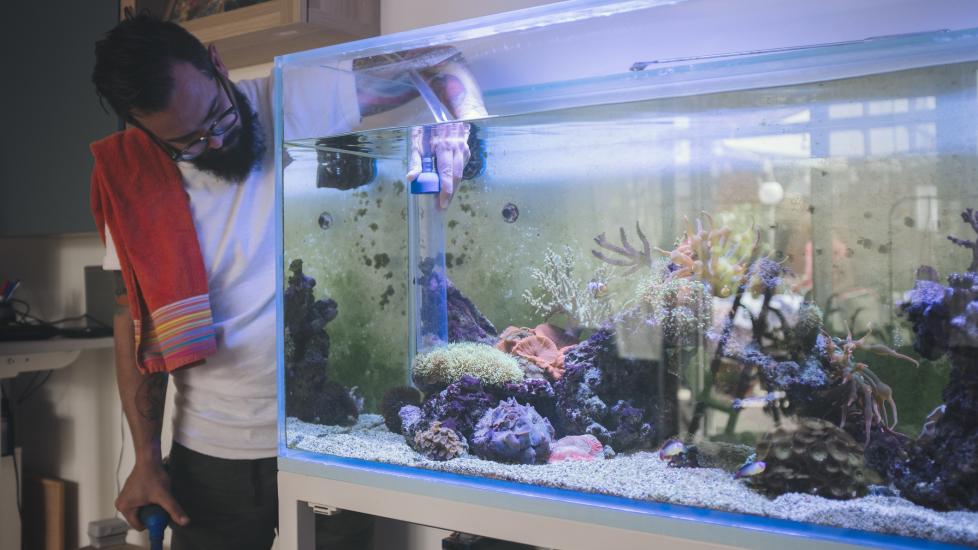Using “Good” Bacteria in Your Aquarium
Upon hearing any mention of bacteria, some people immediately think of germs.
While certain pathogenic microbes can be quite dangerous, there are many types of helpful bacteria that can be beneficial. In fact, without them, life on Earth as we know it would probably not be possible—and neither would recirculating aquarium systems!
Given the relatively small volume of water in even the biggest fish tanks, biological waste products can build up quickly. Some of these wastes are sufficiently toxic to kill fish aquarium livestock, and thus must be controlled.
This can be accomplished by way of regular water exchange. Even so, it is time-consuming and perhaps a bit expensive to constantly perform huge aquarium water changes.
This is where certain types of bacteria help to make aquarium maintenance a lot more manageable. Through their own metabolic activities, these good bacteria either convert toxins into less harmful substances or remove them by taking them into their own bodies.
Here are some important tasks that helpful bacteria perform.
Aquarium Bacteria Facilitate Nitrogen Cycling
Aquarium animals such as fishes release ammonia directly from their gills into aquarium water. In this manner, ammonia levels quickly spike, with deadly results.
These losses—usually total crashes—are especially common in immature systems (i.e., “new tank syndrome”). Thus, nitrogen cycling is perhaps the most important role helpful bacteria play in the aquarium ecosystem.
This is actually a two-part process; one species (e.g., Nitrosomonas) oxidizes really poisonous ammonia to fairly poisonous nitrite, while a second species (e.g., Nitrobacter) oxidizes the nitrite in the aquarium into mildly poisonous nitrate.
Freshwater and saltwater aquarists alike use the term “cycled” to indicate when resident populations of nitrifying bacteria are large enough to keep ammonia concentrations below detectable levels.
The quickest and surest way to initiate cycling is to inoculate the tank with live nitrifying bacteria for aquariums, such as Dr. Tim's® Aquatics Live Nitrifying Bacteria. These products can also be used after water changes or when adding a new fish.
Now, just because nitrate in the aquarium isn’t very toxic doesn’t mean that we shouldn’t be concerned about it. To the contrary, it not only can become harmful to animals at very high concentrations (>50 ppm), but it also serves as a fertilizer for undesirable algae.
While nitrate levels are most often kept in check through regular water exchange, here again, there are good fish aquarium bacteria that can save you substantial work.
These are known as denitrifying bacteria. As part of the process of their anaerobic respiration, denitrifiers convert nitrate into nitrogen gas. They typically require an organic carbon source for energy as well as oxygen concentrations of less than 10 percent.
Helpful Bacteria Keep the Aquarium Clean
Various particulate and dissolved organic substances can foul aquaria by adding unsightly yellowish tints to the water and forming piles of debris, or detritus, on the tank floor.
Here too, water changes can reduce the amount of wastes. Activated carbon is frequently used to remove heavy dissolved organic loads. However, bacteria in aquariums (you guessed it!) can do much to ease this task for the aquarist.
This job is usually assigned to obligately aerobic, heterotrophic bacteria. Unlike autotrophs that can make their own food, heterotrophs must eat some sort of organic carbon.
Along with organics, these microbes might also assimilate excess nitrate and/or phosphate. Some aquarists might even intentionally addorganic carbon (using various liquid or granular bacterial foods) to accelerate nitrate/phosphate removal.
Purple non-sulfur bacteria for fish tanks (or PNSB) can be used for the same purpose here, though they will live in anaerobic areas such as within the sand bed.
In addition to clarifying water and consuming detritus (earning the oft-used moniker “sludge eater”), PNSB can bio-assimilate nitrate. Even more, they act as powerful probiotics.
Creating A Microbial Utopia
Aside from using inoculants, the aquarium keeper can maintain high populations of good bacteria by providing them with a perfect living space.
This is simple with the use high-surface area “biomedia.” These materials are long-lasting, nontoxic and extremely porous. The best come in a block form that can be easily tucked away in the sump or within a filter component.
Not only do these media provide a huge amount of habitable space, but they also allow for a synergistic relationship between different types of microbes.
For example, nitrifying bacteria can colonize the outside, aerobic parts; the nitrate they produce drifts into the deeper, anaerobic pores of the medium where denitrifiers can easily grab and metabolize it.
Necessity of Good Bacteria
Not all bacteria are bad—some bacteria are necessary for a healthy aquarium environment.
You can always rest assured that the good guys are present by putting them there using a quality live inoculant. It’s even better to give them a great place to live. This tiny investment of effort will promote a big, healthy and diverse community of beneficial microbes.
Go big with this. You cannot overdose good bacteria, nor do these good types ever turn harmful. The more of them you can culture, the less time you’ll have to spend on cleaning and water changes.
By Kenneth Wingerter
Featured Image: vgajic/E+ via Getty Images
